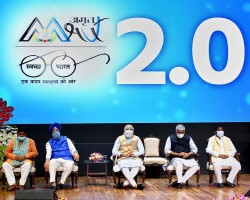SSC Current Affairs
TABLE OF CONTENTS |
| National |
|---|
|
|
|
The Republic Day Parade 2025 will feature the theme 'Swarnim Bharat: Virasat aur Vikas' (Golden India: Heritage and Development), highlighting India's rich cultural heritage and its developmental strides.
Participating States and Union Territories: Fifteen states and UTs have been selected to present their tableaux on Kartavya Path on January 26, 2025: Andhra Pradesh Bihar Chandigarh Dadra and Nagar Haveli & Daman and Diu Goa Gujarat Haryana Jharkhand Karnataka Madhya Pradesh Punjab Tripura Uttarakhand Uttar Pradesh West Bengal Participating Union Ministries and Departments: In addition to the states and UTs, 11 Union ministries and departments will showcase their tableaux, including: Department of Animal Husbandry and Dairying Department of Rural Development Department of Financial Services Department of Social Justice & Empowerment Indian Coast Guard Ministry of Culture Ministry of Earth Sciences (IMD) Ministry of Housing and Urban Affairs (CPWD) Ministry of New and Renewable Energy Ministry of Tribal Affairs Ministry of Women and Child Development Selection Process: The Ministry of Defence oversees a consultative and transparent selection process for the tableaux. An expert committee, comprising eminent personalities from various fields, evaluates the proposals based on theme, concept, design, and visual impact. Due to time constraints in the parade, only a limited number of tableaux are shortlisted. States and UTs not selected for the parade are invited to display their tableaux during Bharat Parv at Red Fort from January 26-31. Significance of the Theme: The chosen theme, 'Swarnim Bharat: Virasat aur Vikas,' aims to showcase India's diverse strengths, cultural inclusiveness, and its journey towards a glorious future. The tableaux will reflect the nation's rich heritage and developmental achievements, resonating with both national and global audiences. This celebration not only honors India's past but also highlights its ongoing progress, embodying the spirit of unity in diversity. What is Tableaux: Tableaux are artistic displays used in parades. They represent cultural, historical, and social themes. Each tableau tells a unique story, denoting the diversity and unity of India. |
|
|
|
About India Republic Day:
Republic Day in India, celebrated on January 26th, is one of the most important national holidays. It marks the day in 1950 when the Constitution of India came into effect, making India a sovereign, democratic republic. The significance of the day is rooted in the adoption of the Constitution, replacing the Government of India Act (1935) as the governing document of the country. Historical Context: January 26, 1930: The Indian National Congress (INC) had declared Purna Swaraj (complete independence) from British rule, and the day was celebrated as Independence Day until India gained freedom in 1947. After independence, the need for a Constitution to govern the newly independent nation arose. A Constituent Assembly was formed, which worked on drafting the Constitution for about 2.5 years. On November 26, 1949, the Constitution was adopted, but it came into effect on January 26, 1950. This date was chosen to honor the earlier declaration of Purna Swaraj. |
|
|
|
Indore's Devi Ahilyabai Holkar Airport has become India's first zero-waste airport with the inauguration of a 3,000-square-foot Material Recovery Facility (MRF).
Key Features of the Zero-Waste Initiative: 4R Strategy Implementation: The airport employs the 4R principles—Reduce, Reuse, Recycle, and Recover—to minimize environmental impact. Comprehensive Waste Management: A state-of-the-art waste processing plant handles approximately 750 kilograms of daily waste on-site, significantly reducing landfill dependency. Wet Waste Processing Unit: Organic waste is converted into nutrient-rich compost, which is utilized for the airport's landscaping needs. Material Recovery Facility (MRF): Dry waste is meticulously sorted into ten distinct categories for recycling, ensuring efficient resource recovery. Sustainable Model: Revenue generated from the sale of compost and recycled materials is planned to fund the salaries of dedicated green workers from the third year onwards, ensuring the project's long-term viability. Collaborative Efforts: This achievement results from a partnership between IndiGo's CSR initiative, IndiGoReach, the Airports Authority of India (AAI), and the AAS Foundation, Indore. Their combined efforts have set a new standard for sustainable waste management in the aviation industry. Inauguration: The facility was inaugurated by Union Minister of Civil Aviation, Shri Rammohan Naidu, along with other dignitaries, marking a significant milestone in India's commitment to environmental sustainability. This initiative not only enhances Indore's reputation as India's cleanest city but also sets a precedent for other airports nationwide to adopt sustainable waste management practices. |
| Environment |
|
|
|
Why in the news?
This Christmas, papier mache artisans in Srinagar have given wings to thousands of dodos, a bird that became extinct in 1681 within 80 years of its interaction with humans and exposure to depleting forests. About Dodo Bird: Scientific name: Raphus cucullatus Characteristics: It had grayish feathers and a distinctive large, hooked beak. Habitat: Endemic to the island of Mauritius and lived in forests Evolutionary History: It evolved to be flightless due to the absence of predators on Mauritius. The dodo likely had strong running abilities. Discovery and Extinction: Extinct in 1681. Dodos were last seen in Mauritius. The bird is important to the place and is the national emblem there. |
| Sports |
|
|
|
India clinched the inaugural Under-19 Women’s Asia Cup title in 2024 after defeating Bangladesh in a thrilling final. The victory marked a historic moment for Indian women’s cricket as it was the first edition of the tournament, which provided young talent with a platform to showcase their skills on the international stage.
Key Highlights of India’s Victory: Final Match Overview: India defeated Bangladesh in the final, showcasing dominant performance in both batting and bowling. The match was held in a competitive atmosphere, with both teams putting up a strong fight, but India emerged victorious with a comprehensive all-round display. The final match held at the Bayuemas Oval in Kuala Lumpur, Malaysia. India’s Performance: Batting: The Indian team displayed solid batting performances, with key players stepping up to build partnerships and set a competitive total. The middle-order played a crucial role in stabilizing the innings, ensuring that India posted a defendable total. Bowling: India’s bowlers, led by their captain and key performers, restricted Bangladesh to a modest score. The bowlers used variations and disciplined line and length to take crucial wickets at key moments. Standout Players: Several young Indian players delivered standout performances, both with the bat and the ball. The team’s leadership was also instrumental in guiding the youngsters through pressure situations during the final. Bangladesh’s Challenge: Bangladesh fought hard, but India’s superior all-round performance ensured they couldn’t get over the line. India’s bowlers kept the pressure on, while the fielding was sharp, preventing any major partnerships from forming. Significance of the Title: Historic Achievement: This was a significant milestone for Indian women’s cricket, marking the first-ever Under-19 Women’s Asia Cup win. The victory highlights the growing strength of women’s cricket in India and the depth of young talent. Building for the Future: The Under-19 Women’s Asia Cup served as a crucial platform for scouting young talent, and this win gives India a boost ahead of future tournaments like the ICC Under-19 Women’s World Cup. Captain and Coach’s Role: The Indian team’s captain played a vital role in the team’s leadership and strategy, helping to maintain focus and composure throughout the tournament. The coach’s guidance also helped develop the players’ skills and mental toughness. Conclusion: India’s triumph in the inaugural Under-19 Women’s Asia Cup is a historic achievement for Indian women’s cricket, underlining the country’s growing dominance in women’s sports. The victory not only rewards the players’ hard work but also signals a bright future for Indian women’s cricket, with a promising generation of young talent rising through the ranks. IN SHORT: What: Under-19 Women's Asia Cup Who: India defeated Bangladesh in a thrilling final. Where: Final held at the Bayuemas Oval, Kuala Lumpur, Malaysia. When: December 22, 2024. |
|
|
|
Bihar is set to host the Women's Kabaddi World Cup in March 2025, marking the state's second time organizing this prestigious event, following the inaugural tournament in 2012.
Venue: The matches will take place in the indoor hall of the Rajgir Sports Academy, a facility equipped with modern amenities to accommodate international sporting events. Participating Nations: The tournament is expected to feature teams from 14 countries, including: Asia: India, China, Japan, South Korea, Nepal, Pakistan, Iran, Indonesia, Sri Lanka, Thailand. Other Regions: Poland, Argentina, South Africa. Historical Context: Bihar previously hosted the first Women's Kabaddi World Cup in 2012 at the Patliputra Sports Complex in Patna, where India emerged victorious against Iran in the final. Significance: Hosting the Women's Kabaddi World Cup for the second time underscores Bihar's commitment to promoting sports and providing a platform for women's participation in international competitions. Preparations: The Bihar State Sports Authority (BSSA) is undertaking comprehensive preparations to ensure the event's success, including accommodations for teams and officials at the Rajgir Sports Academy. This event is anticipated to further elevate the profile of kabaddi on the global stage and inspire increased participation in the sport, particularly among women. |
| Deaths |
|
|
|
Renowned Indian filmmaker Shyam Benegal passed away on December 23, 2024, at the age of 90, due to complications from chronic kidney disease.
Early Life and Career: Born on December 14, 1934, in Hyderabad, Benegal developed an early interest in cinema, creating his first film at the age of twelve. He earned a Master's degree in Economics from Osmania University, where he also established the Hyderabad Film Society. Contributions to Indian Cinema: Benegal was a pioneer of the parallel cinema movement in India during the 1970s, focusing on social issues and realistic storytelling. His notable films include: Ankur (1974) Nishant (1975) Manthan (1976) Bhumika (1977) Accolades: Throughout his career, Benegal received numerous awards, including: Padma Shri (1976) Padma Bhushan (1991) Dadasaheb Phalke Award (2005) He also won eighteen National Film Awards, a Filmfare Award, and a Nandi Award, underscoring his significant impact on Indian cinema. Legacy: Shyam Benegal's films are known for their depth, humanism, and sensitivity toward societal issues. His ability to portray real-life struggles through engaging narratives has left an indelible mark on Indian cinema. |
| Important Days |
|
|
|
National Consumer Rights Day, observed annually on December 24, commemorates the enactment of the Consumer Protection Act, 1986.
Government bodies, consumer protection organisations, and educational institutions mark the occasion with awareness campaigns, workshops, and educational programs. Why Is December 24 Celebrated As National Consumer Day? In India, December 24 is celebrated every year as the National Consumer Day to commemorate the enactment of the Consumer Protection Act 1986. The law enacted to protect the rights of the consumers received the assent of the President on this date. The goal of National Consumer Day is to educate all consumers about their rights and obligations. Bharatiya Grahak Divas 2024: History And Significance The Consumer Protection Bill got the President’s assent on December 24, 1986. To recognise the significance of the day, December 24 is being celebrated as the National Consumer Day every year. In 1991, 1993, and 2002, the Consumer Protection Act underwent additional revisions to improve its efficacy and consumer-friendliness. The amended Act was enacted in March 2003. The 1986 Consumer Protection Act has now been replaced by the Consumer Protection Act 2019. The law came into effect in July 2020. Consumer complaints can now be easily and quickly resolved under the 2019 Act. It protects customers and encourages them to file complaints against deficiencies in products and services. The Act lists five duties that every consumer should fulfil in addition to the six consumer rights that all citizens of country are entitled to. In addition to numerous other unfair trade practices, consumers are protected from hoarding, fake or misleading advertisements, fraudulent promises, and inadequate or subpar products. An efficient complaint redressal platform allows customers to file their complaints without any hassle. The government has also set up the National Consumer Helpline (NCH) as a single point access for redressal of all consumer grievances. CONSUMER RIGHTS IN INDIA: Right to safety Protection from goods and services that may be hazardous to life or property. Right to information Access to accurate product, service, and pricing details. Right to choose Freedom to select from a variety of available products or services. Right to be heard The assurance that consumer complaints and concerns will be acknowledged and addressed. Right to seek reparation The ability to claim compensation and resolve grievances in cases of unfair practices or exploitation. Right to consumer education Awareness about consumer rights and the remedies available to protect them. |
| Government Schemes in News |
|
|
|
What is AMRUT Scheme?
Atal Mission for Rejuvenation and Urban Transformation (AMRUT) was launched on 25th June 2015 in 500 selected cities across the country, covering around 60% of the urban population. The mission targets enhancing basic infrastructure and implementing urban reforms for selected cities, encompassing water supply, sewerage, drainage, green spaces, non-motorised transport, and capacity building. AMRUT 2.0 Scheme: The Atal Mission for Rejuvenation and Urban Transformation 2.0 (AMRUT 2.0) scheme was launched on 01 October, 2021 for the period of 05 years i.e. from the financial year 2021-22 to the financial year 2025-26. AMRUT 2.0 is designed to provide universal coverage of water supply through functional taps to all households in all the statutory towns in the country and coverage of sewerage/septage management in 500 cities covered in the first phase of the AMRUT scheme. The total indicative outlay for AMRUT 2.0 is ₹2,99,000 crore including Central outlay of ₹76,760 crore for five years. This outlay includes funding of ₹22,000 crore (₹10,000 crore as Central Assistance) for ongoing projects of AMRUT till March 2023. |
|
<< 23-Dec-24
|
|
|







